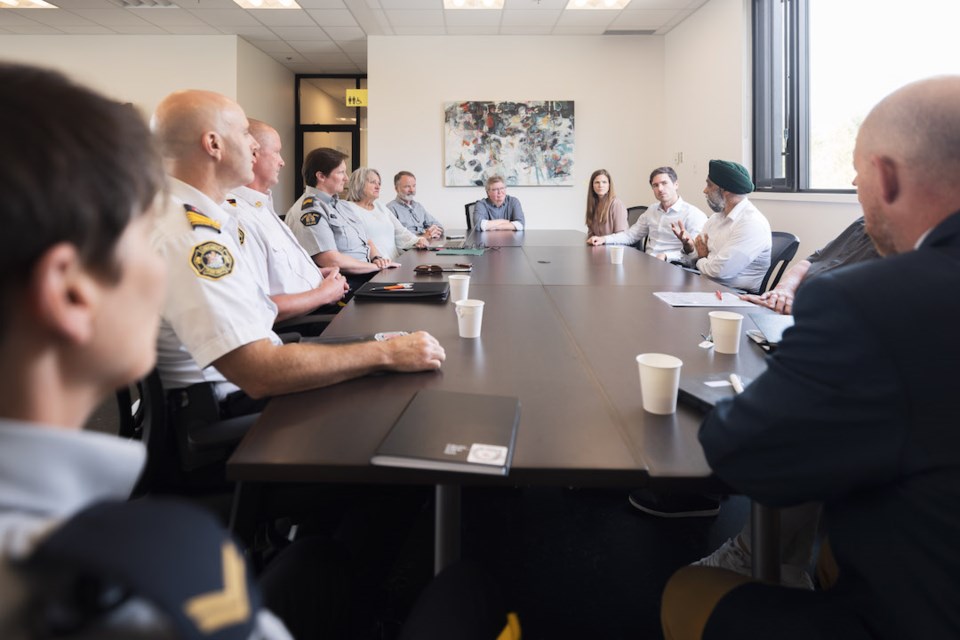Canadian Minister of Emergency Preparedness Harjit Sajjan met with local government leaders and community organizations on the lower Sunshine Coast (with a stop for gelato) on Sept. 5.
Sajjan, also minister responsible for the BC-focused Pacific Economic Development Agency of Canada (PacifiCan), said visiting the Coast gave him insight into local needs and challenges. His tour of the Coast (though he’s visited before in non-ministerial capacities) included lunch at the Village Restaurant – across from the PacifiCan-funded construction on Inlet Avenue – and meetings with the Sechelt and Gibsons chambers of commerce, Sunshine Coast Regional Economic Development Organization (SCREDO) and Community Futures; as well as a meeting with the fire chiefs, RCMP, and local government elected representatives about emergency preparedness. Sajjan, and West Vancouver-Sunshine Coast-Sea to Sky Country MP Patrick Weiler, dropped by the Coast Reporter offices following his other meetings.
Economic development
Economic development appeared to be a focus for the Coast visit, getting “a feel for what the vision is” on the Coast and the support needed from PacifiCan and other government departments.
Sajjan spoke to the benefit of having an economic growth strategy that’s well-endorsed by municipalities, First Nations and local business and that accounts for the factors that affect local economy (housing, transportation, etc.).
“Having that wider vision is so important,” said Sajjan
When he’s visiting other communities in B.C., Sajjan said there’s lots of asks for funding, and what the government is looking for is a solid vision for economic growth. “That shows you have a comprehensive plan for a community.”
Sajjan said he was impressed with how the Coast local governments – and chambers of commerce – have been linking together, and that doing so gives them a stronger voice.
“Rather than looking at as, what's for Sechelt, what's for Gibsons, they're coming together as municipalities and advocating for one another,” said Sajjan. “They're discussing what the priorities are.
“That has a lot more weight when it comes to advocating at the provincial and the federal level.”
Emergency preparedness
Naturally, with extreme weather events and wildfire wreaking havoc on B.C., Sajjan’s other file, emergency preparedness, is of particular relevance.
What Sajjan says he is hearing from people in B.C. that they want to know that if there’s a disaster, the federal response will be there. Sajjan said he’s well familiar with federal capabilities on the B.C. coastline, including Coast Guard, from his time as Minister of National Defence (2015-2021). He said the federal government has the resources for disaster response but they now need to “codify it a little bit more.”
“Things are getting worse and worse when it comes to natural disasters and we need to make sure that we put systems in place, it can't be just about on an ad hoc basis,” he said. “The systems that we've had have worked well in the past, but they're not conducive to year after year and all year round emergencies.”
While federal disaster preparedness conversations happen more between the upper levels of government, some discussions have started at the municipal levels, said Sajjan. Federally, with resources spread across the country, it’s about anticipating where the needs are. “You look at what emergency you may deal with [and] put the right resources at the right areas,” he said. “Municipal is a very important one, where we do need to put more emphasis on, but we have started.” (Sajjan gave the example of the federal government funding training 1,000 new firefighters with emphasis on training leaders and trainers.)
Predicting and preventing potential disasters and avoiding the need to evacuate is paramount, but “you do need to plan for the worst case scenario,” said Sajjan. A plan needs to be put into place for mass evacuation and rehearsed at all levels, which includes the contingency plans – those “what ifs.”
“The B.C. government does have plans in place and for federally, I know that we have support that we can put into place. I know this because I put [these] into place during COVID time … we had ships all around the coast ready to go to support if communities actually needed it. We also even had the Coast Guard ready to go. So we have the different abilities to be able to support [communities].
Sajjan spoke to a plan being in place for the successful evacuation of Yellowknife and gave an example of how earthquake planning for the Vancouver area meant engineering resources were pre-positioned in Chilliwack to help with the November 2021 atmospheric river response, when all the roads to the Lower Mainland were cut off.
“Maui was a perfect example of why you need to be ready,” said Sajjan, but rather than asking how do you get everyone out, “It should be how do you prevent what took place in Maui in the first place?”
Sajjan said that there’s a federal command and control centre that works with all the provinces and territories and that briefs him. “Today, they gave me an update [for] all the emergency areas, including a B.C. and if there was a problem here in Sechelt, I'd know about it, even beforehand.”




